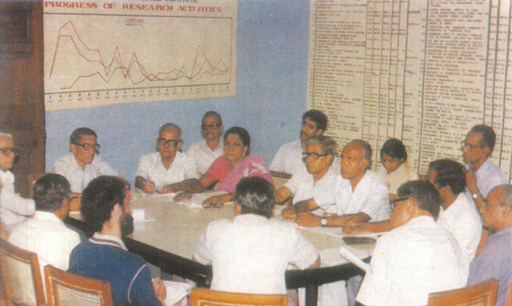2. THE FORMATIVE YEARS
|
Padmashree Dr DR Nagpaul |
|
There is a dread disease which so prepares its
victim, as it were, for death… a dread disease, in which the
struggle between soul and body is so gradual, quiet, and solemn,
and the results so sure, that day by day, and grain by grain, the
mortal part wastes and withers away, so that the spirit grows light….
a disease in which death and life are so strangely blended that
death takes the glow and hue of life, and life the gaunt and grisly
form of death - a disease which medicine never cured, wealth warded
off, or poverty could boast exemption from - which sometimes moves
in giant strides, or sometimes at a tardy sluggish pace, but, slow
or quick, is ever sure and certain. |
2.1 Development of protocols
Once the Institute was established, the very first task was to devise and implement a work plan. The NTI developed the tradition of putting together protocols for a variety of studies dealing with different aspects of TB control. Five protocols in the inauguration year (1-5), 15 in the next year (6-20) and 20 during the year 1961 (21-40) were written (Annexure II). Apart from the number, one will be overawed by the variety of hypotheses and ideas that passed through the stages of formulation, scrutiny for feasibility, field testing for practicality and applicability, during this short period. To gain acceptance, every idea must have enough substance to make some contribution, to the overall goals of the NTI. Hence, every idea generated by an individual officer or a group of officers, must gain credence by consultations with personnel from other sections.
A Technical Coordinating Committee (TCC) was constituted for this purpose. The TCC headed by the Director had officers from every section as its members and invited others when required. Meetings were held once in a week or more often when necessary in the committee room commonly known as TCC room. A draft protocol would be prepared elaborating the idea in clear terms regarding the objectives, methodology, personnel, material required, time involved and funding. It would then be presented for approval to the TCC. It would be the privilege of each member to carefully scrutinise and critically examine the protocol presented. As each member hailed from a different background, the ideas presented would be viewed from different angles. The queries that arise in the ensuing discussion would be different from the ones earlier encountered. It would be the duty of the author of the protocol to defend the hypothesis to gain acceptance. All participants had the freedom to speak for or against the procedure sans hierarchy. Therefore, there were, long discussions. Logically, by this process, the original idea got enriched by the contribution of others. Additionally, the entire team became aware of the activities of different sections and of the institute as a whole29.
In early 60s, the idea of conducting operations research applicable to public health aspects was fairly new. Health practices, in vogue then, focussed on the delivery of highly complex services to millions of people through thousands of doctors and other health workers. To formulate important questions in health research or to refine methods and instruments of research was not easy. The size of our country, different languages spoken and customs followed, brought its own problems.
 TCC in Progress |
Thus, the TCC became the hard testing ground for all the ideas. Only successful ones would be referred to as a research project/protocol and would be passed for field work. The TCC also reviewed the work done and modified the course of work in progress, if warranted. After the completion of the work, it would conduct a peer review on the analysis and presentation of the work before publication. Large scale quantitative community based studies in public health give rise to a variety of difficulties, especially those concerning the precision of the tools used because the tools themselves have components of fluctuations or ranges in interpreting them. For e.g., problems on the large scale - what sample size would be appropriate to represent the country? On the smaller scale - if the symptom is used as a tool, which definition of symptom/symptoms would be the most accurate in netting most TB patients? Further there would be other issues like persistence or non-persistence, severity or/and duration of symptoms. Tuberculin testing is a simple quantitative procedure. Conversely, the interpretation of tuberculin test is not easy i.e. who is infected and who is not? As it was found in later years, this question gets complicated as is true with the chest X-ray reading. Much exploration is required to standardise tools so that they are comprehensive, simple and can be adaptable to a variety of field conditions29. Thus, it is astonishing to note that way back in 1959 itself, in its apex technical forum, the NTI had adopted the systems concept and a multi-disciplinary approach which overcame artificial boundaries. It was highly amenable to rapid learning from exchange of information between groups. It facilitated the use of formalised and objective investigative procedures. It focused strongly on taking up practical and relevant problems. More important, it weeded out repetitive or irrelevant studies or those that maintained status quo.
